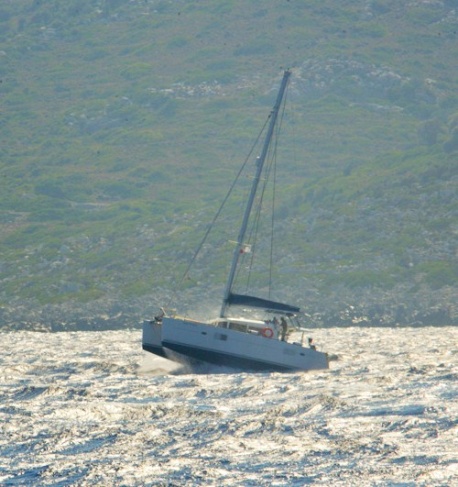– Nothing New Under the Sun –
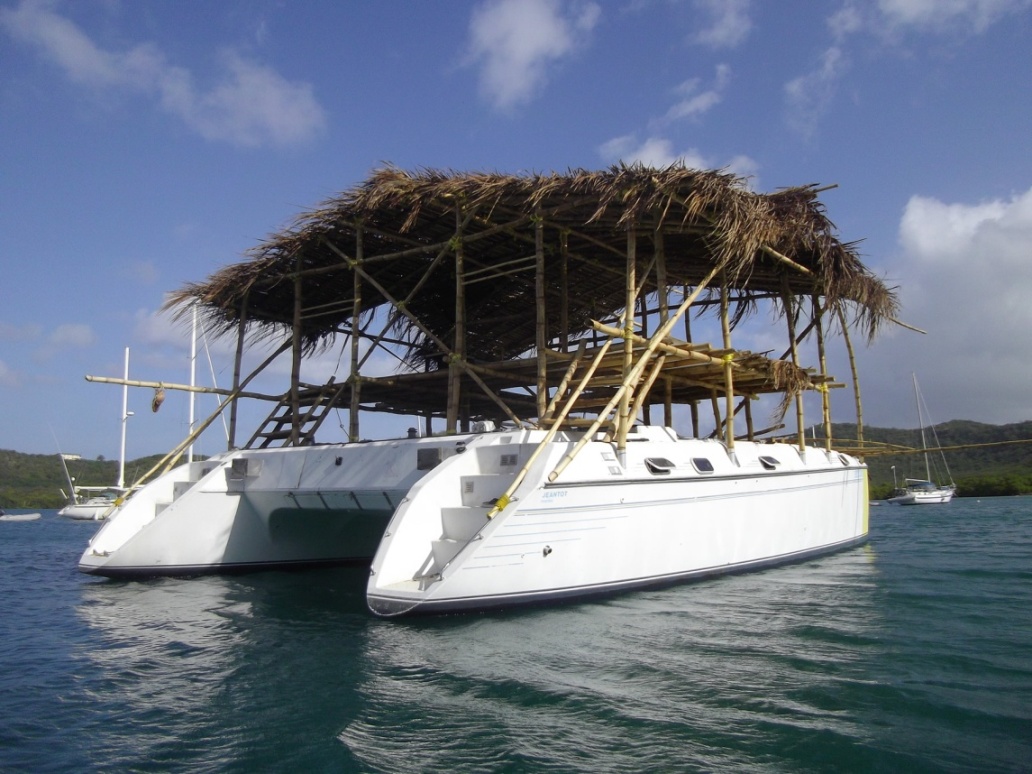
Back in the dark ages when the Antares 44 was initially designed, sailing catamaran offerings were already dominated by the French builders. It was apparent that nobody on the eastern side of the Atlantic took seriously any effort to get out of the sun and they never went boating in anything other than warm blue sky weather. The designs told you so and the promotional imagery confirmed it.
Those of us who envisioned boating in anything other than seasonable Mediterranean conditions had to give consideration to enclosure options for the ‘cockpit’ which space had become a major part of the accommodations. Previous designs for the North American cruising markets had initially followed the standing multi-hull aficionado’s code and distained any provision for canvaswork, perhaps as it was a heresy to the dream of warm Caribbean waters. Cruising owners of those boats however were generally more practical and universally installed soft bimini tops, progressed to full enclosures and eventually asked for ‘hard’ bimini tops.
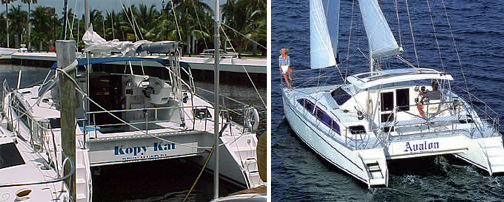
We were there first
Fitting canvaswork to incongruent shapes with all the necessary openings etc. is not only difficult, it has the strong potential to look like a cat’s breakfast, despite the skills of the seamster,
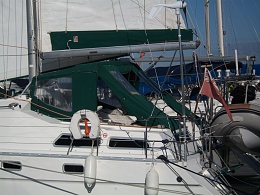
or his apparent ambition, (yacht designers beware).
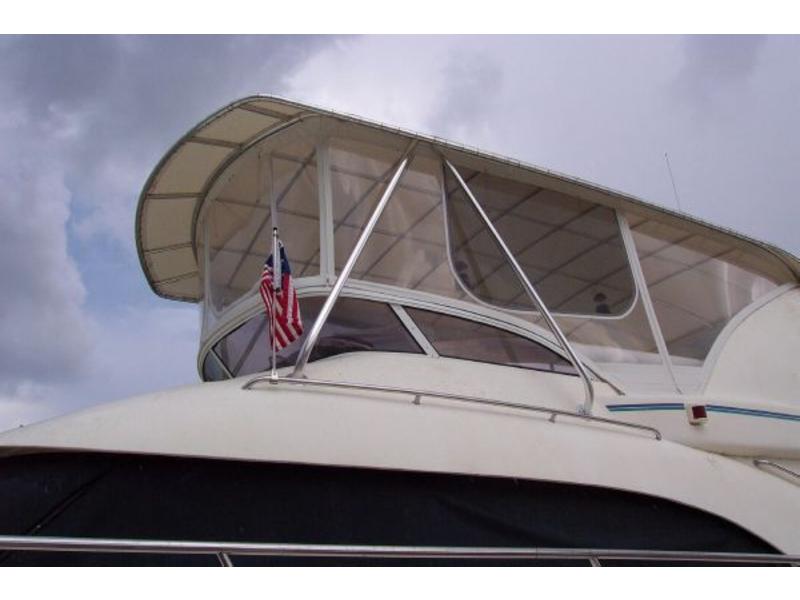
pop up tent?
Though it was a deviation from the prevailing multihull norm, the decision was made that the 44 would have not only provision for canvaswork at the design stage but also a multi-function standard hardtop, no afterthoughts or tag-alongs. These requirements definitely put the design out of the running for fashion plate of the year. Time marches on.
We are now ten+ years along and it is interesting to note that there must be some practical demand from at least some cruising cat customers that is messing with the artistic visions of yacht designers across the Atlantic. Issues like ‘lines of sight’, ‘the ergonomics of safely moving about’, ‘shelter’, ‘versatility’, don’t seem to carry much weight with the initial design so when a potential owner says “I really need such and such,” it gets winkled in after the fact. The trouble is apparent; doing some major component add-on really shows up some of the initial design compromises and goofiness.
Surprisingly, adding on really large and obvious accessory pieces of junk is apparently quite OK. If you are going to commit a robbery, you may as well make it worthwhile.
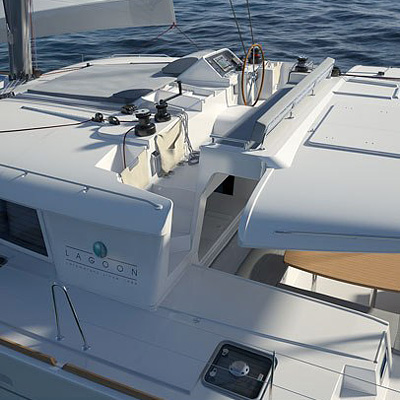
Ay, Carumba.
Some examples are so complicated, they confuse everyone sufficiently to pass as acceptable while any vestigial aesthetic or practical design elements (possibly scant in the first place) are subsumed.
And now that forced sun exposure is finally acknowledged to be not OK,

it may even become necessary to add a third floor roof.
Lots of this kind of craziness results from a questionable set of design parameters in the first place. Squirming around to force cockpit floors to be contiguous with the bridge deck (‘must have’ patio doors) really compromises the relative deck levels and staircase issues. Trying then to achieve a sheltered helm with actual forward visibility becomes even more problematic. Sticking the helmsman’s head out through a hole in the hardtop becomes a common solution. Such an arrangement would be a laughable proposition if we were not now accustomed to seeing it so often, and subsequently purchased.
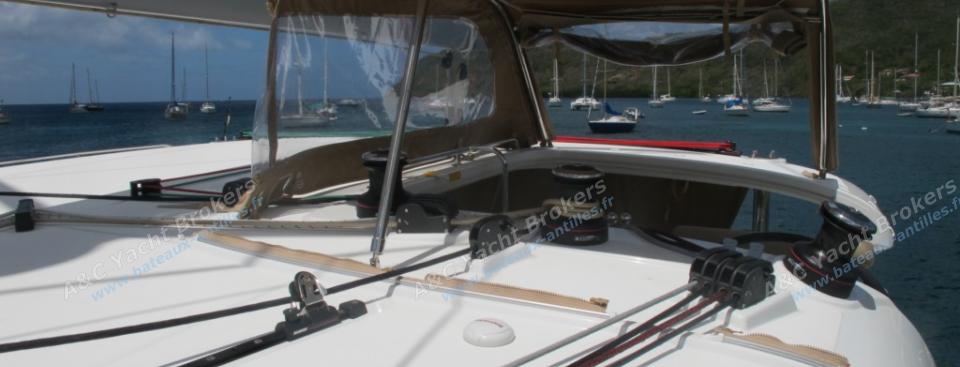
The endemic problem is; cruising sailing cats continue to be plagued with the carbuncles of charter boat design.
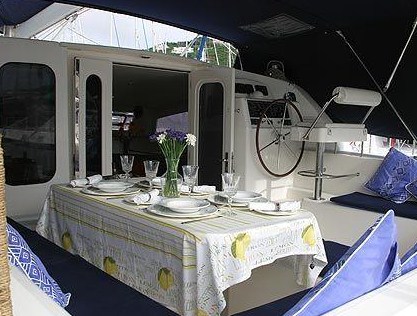
That market seems to gets what it needs regardless, and isn’t confused about what really counts.
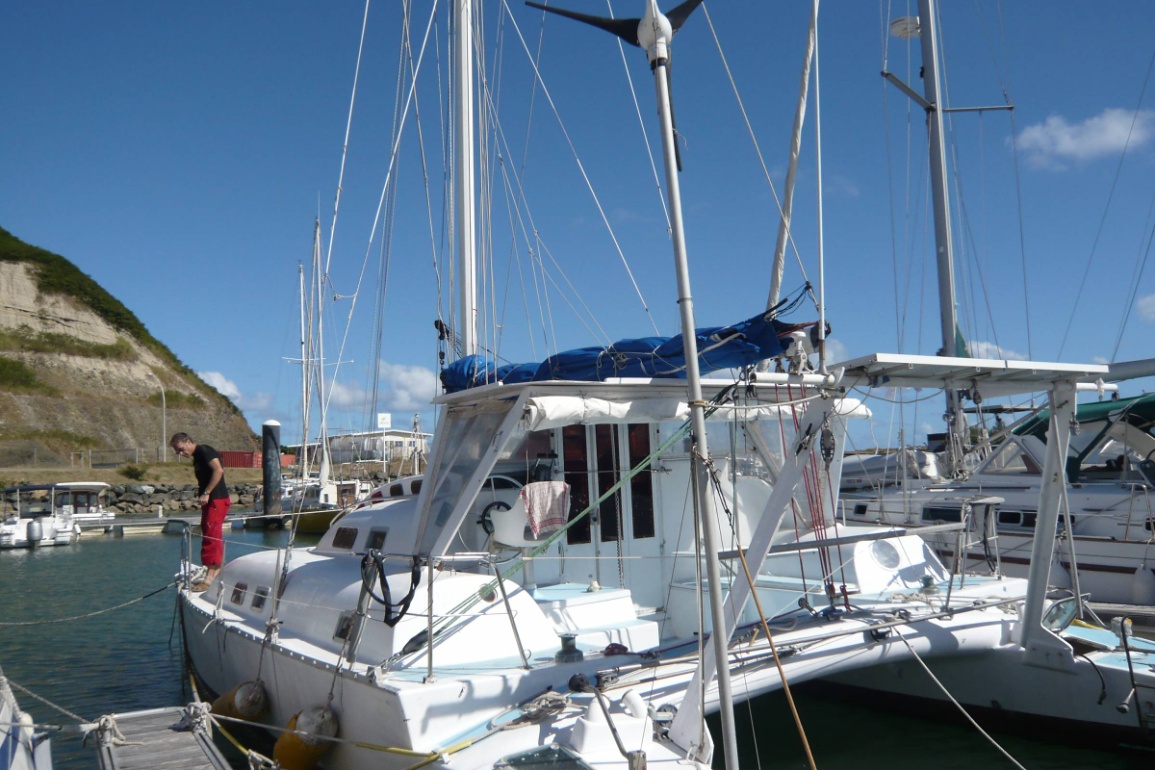
Solving all the issues after the fact can make for some dense installations. It’s easy to forget that the boat should actually sail (at least if it is intended for cruising)and that means that strong sheeting anchor points/tracks, correct sheeting angles for a variety of sails and correct sheet winch positioning may take priority over the shape of the dining room table in the cockpit.
When considering cockpit enclosures, there are several associated issues, the effective handling of which may not be apparent at the boat show dock…
Moving the mainsheet from the aft deck to an overhead position on a hard bimini top offers some obvious advantages in dealing with the working cockpit space but its support structure must be extraordinarily strong in both the vertical and horizontal planes. For example, a hard sheeted main on the Antares 44 will exert about 3,000lb. (1400kg.) upward working load pull on the hardtop that carries its track (try the Harken formulae on their web site). The potential combination of extraordinary shock forces experienced in an accidental jibe should be very concerning to the designer of the hardtop supports.
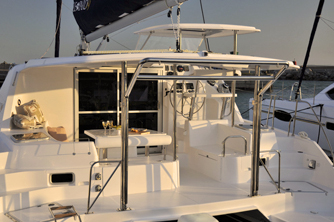
Stainless steel tube constructions may be less than elegant and sometimes suggest that an appreciation of the forces involved and how to efficiently absorb them hasn’t been on the front burner. In the case above, the presumption appears to be that mainsheet side loading will be absorbed by the hardtop connection to the deckhouse. (Maybe you will be washed off the stern before that is an issue?)
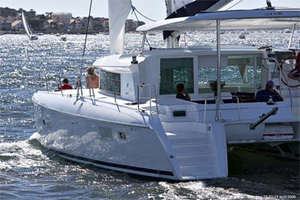
If it works it works I guess, but how close are these types of installation to the engineering margins?
To permit some sleep at night, the design of the Antares 44 hardtop entailed a finite element engineering analysis (FEA)which dictated a carbon fibre transverse beam incorporated into the moulding and a triangulated stainless tube support structure, (what a bunch of chickens).
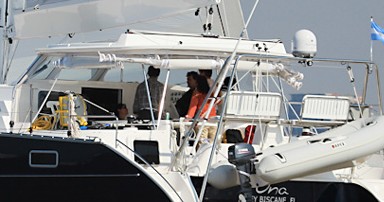
Hey! Straighten the dingy!
Whatever is propped up over the cockpit, it needs to be as light weight as possible, so size does matter, usually.
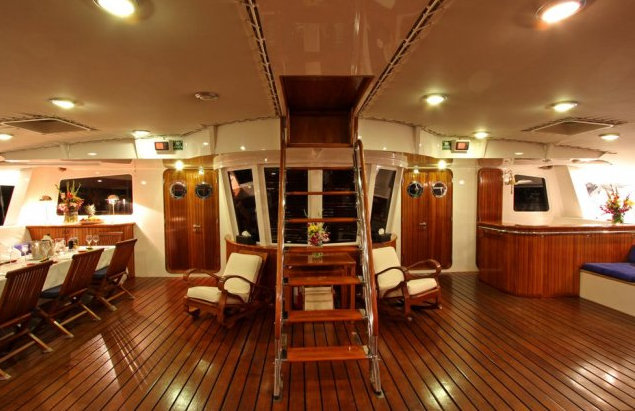
This looks like a fabric bimini top from the underside?, but I guess not, (lights, hatches, companionway, span, etc.). The lacings must be a style statement.
The shape and size of a hardtop should consider the effective shade offered and the clearance for ideal headsail sheeting angles. There seems to be a lot of compromise these days in this regard, something to watch for if ‘sailing’ appears to be less important than entertaining. The A44’s ‘eyebrow’ may give it a particular look but it is actually a practical forward extension of the hardtop, intended to shade the dashboard shelf and give the helmsman some relief as he sails her into the setting sun.
Cruising boats demand solar panels these days (more and more)and there are few flatish locations for them, a hardtop bimini being one of them. Solar panel performance is impaired by excess heat so some provision for cooling airflow under them is desirable. This may be accomplished in the hardtop moulding if the design recognizes the requirement in the first place. The moulding can also recess the panel installation as well as any other mounted equipment to provide a flush surface. In the event of an accidental jibe, any trailing sheet lines won’t snag and tear stuff off. The resultant convolutions in the moulding reinforce the structure and may permit the use of lighter laminates (good).
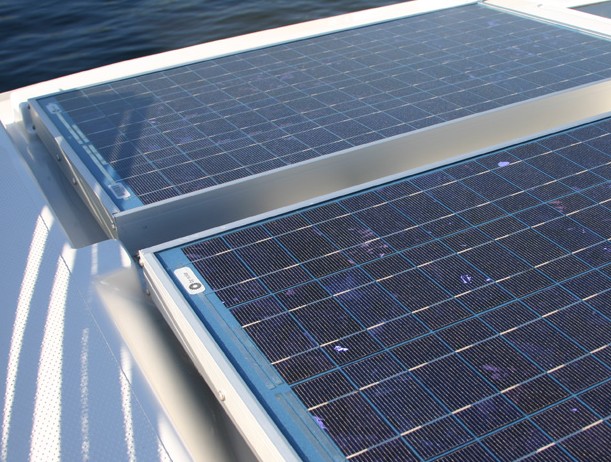
You need to be able to look up at the sails from the helm, hatches in the hardtop located for strategic lines of sight are appreciated and offer ventilation options.
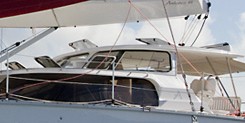
Flush hatch arrangements may have drainage figured into the moulding. Recently the Antares 44’s original sliding flush bimini hatches have given way to a preference for hinged models that catch more ventilating breeze, an amenity that does make them somewhat vulnerable but that is the compromise.
From experience with older designs, it was apparent that hardtop bimini design needed to address the issue of drainage for the whole entity. The catchment area for the Antares 44 is about 100 sq. ft. and streaming water, if allowed to find its own path, inevitably finds the most inconvenient spot on the perimeter to drip from. A ‘gutter’ around the edge with a dedicated drain is appreciated. A downspout tube connections may be arranged at the lowest sections to channel the water away, or to a container if it is fresh, and the canvaswork may also incorporate drain tubes in its construction. These are difficult details to accommodate after the fact. In the picture below, the side curtain has a drain tube installed along its aft edge (white).
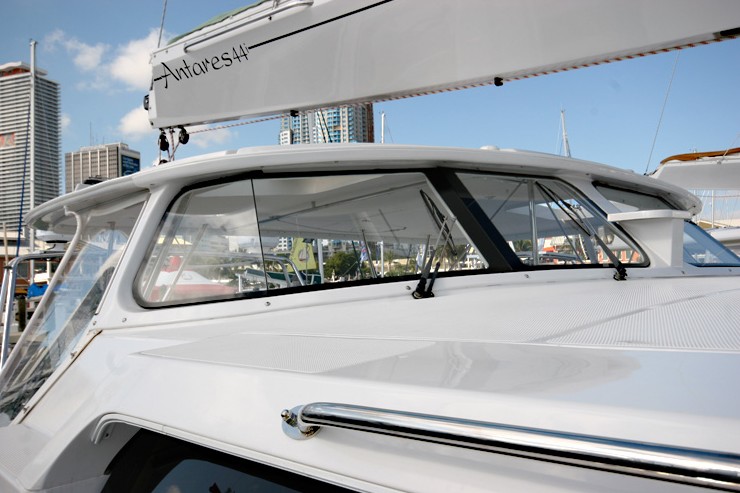
This picture also illustrates the option of replacing soft windshield canvaswork with a glass framed installation. Though conceived of at initial vessel design as a possible future development, it happened only after several years of production, by which time the ‘powerboat’ connotations were less blasphemous to the multihull community. This windshield design uses ‘aquarium’ joints for the outer facets to avoid impairing the helmsman’s line of sight. Of note is the centreline step to assist in access to the hardtop. All working deck surfaces need to be as level as possible and have non-skid surfaces. They ought to be provided wherever you are likely to find yourself, the hardtop is such a zone, note also the handrail on the MainTamer boom.
Canvaswork is never illustrated in presentation drawings and seldom in promotional shots. Once it is fitted with all the joints, zippers, opening panels, bug screens etc., it just doesn’t look very nice.
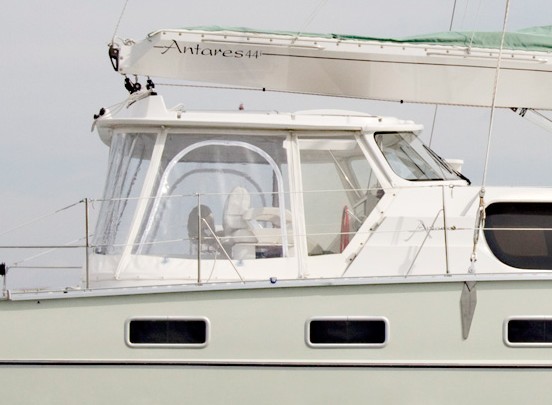
The best aesthetic ammunition you can give the fabricator is places to land his edges that make sense geometrically. The Antares 44 hardtop has an underside rebate to mount the canvas track. The rebate surface is geometrically contiguous with the aft cabin side and the deckhouse surfaces below.
As the boat’s designer, I think that canvaswork should be as innocuous as possible and that dictates that it should be white. There is an aesthetic reason why colours are applied below the sheerline and not above, it makes the boat look sleeker and lighter above. In spite of all the practicality, there are design lines that are not arbitrary, hopefully appealing ones.
Arch constructions are frequently associated with canvaswork and hardtops.

This one rather overwhelms the whole vessel design, (and the bimini still looks rather pathetic). Though an arch may incorporate dingy davits if the geometry permits, this one looks like it is too far forward. I have tried drawing solid construction arches for sailboats and there are a number of stoppers to my mind.
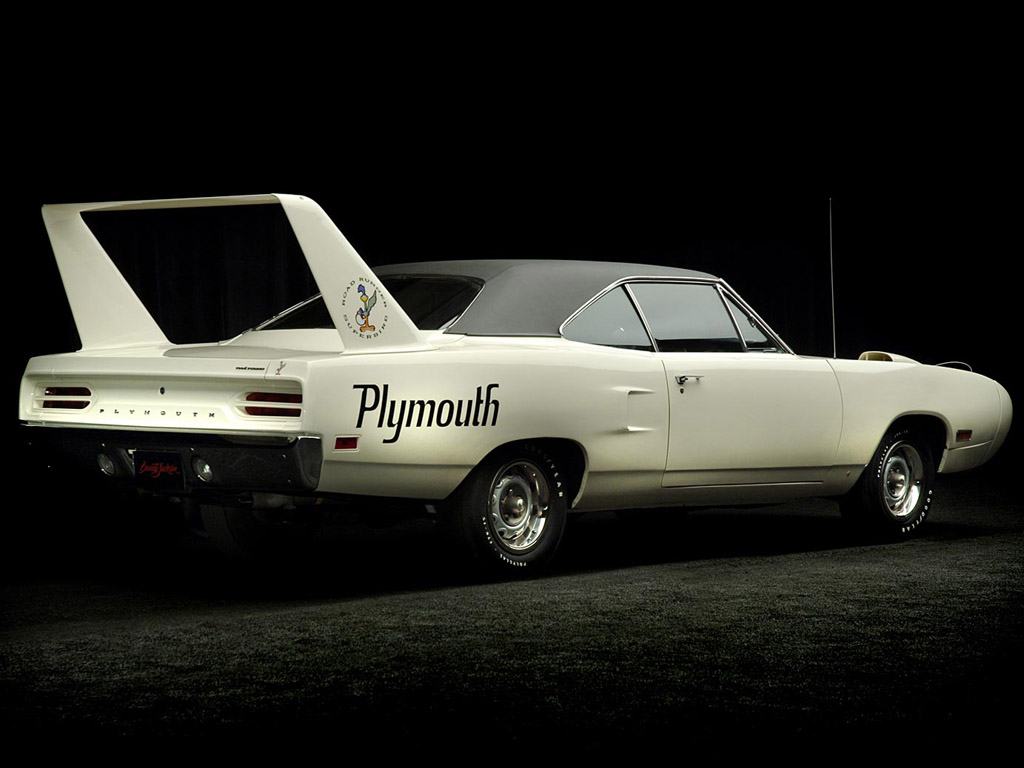
1970 Plymouth Roadrunner Superbird
Among them the perhaps inappropriate aesthetic associations, but also the weight, windage, functionality and obstruction issues. I can’t make one work for me (on a sailboat), so far anyway.
The Antares 44 was initially designed without any provision for an arch in the mistaken belief that all possible requirements for equipment mounting etc. had been satisfied. Owner #3 requested one however, having seen such an item on an earlier design and not felt any appreciable lightening of his wallet. It was so well received, the arch installation became the standard and the design still stands in production today. It is a tough fabrication to pull off as the mounting points in the deck moulding are not ‘level’, as they could have been if I had thought of it. (Those of you who have asked, “What would you have done differently?”- take note.)

The arch is included in this discussion as it carries a canvas awning extension (rolled up blue thing above!) in addition to a multitude of accessory baggage (not the valued owners), some of which is visible here; yet more solar panels, one or two domes, multiple antennae, BBQ raft, dingy, extra cockpit seating, occasional windmills, etc. All the junk on the arch is aft of the boom end so there is little danger of snagging anything (good).
The curve of the Antares 44’s arch matches the camber of the hardtop (I did think of that) which helps with the fit of the awning.
This example below of the same ideas applied to another boat design illustrates the potential for coverage, support and fit issues with the inevitable afterthoughts.
 Boats are laden with more and more ‘new’ accessory items but some of the stuff has a long history and a foundation in practicality; it is expedient to consider the possibility some things will come back into vogue within the lifespan of the design and make provisions.
Boats are laden with more and more ‘new’ accessory items but some of the stuff has a long history and a foundation in practicality; it is expedient to consider the possibility some things will come back into vogue within the lifespan of the design and make provisions.
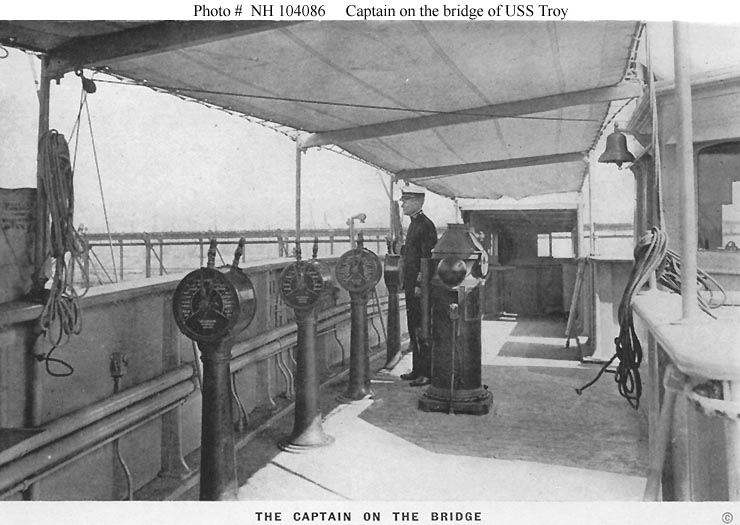 If a vessel’s initial design doesn’t address the issues, its owners will. Here are some illustrations of the compromises associated with after the fact installations.
If a vessel’s initial design doesn’t address the issues, its owners will. Here are some illustrations of the compromises associated with after the fact installations.

I imagine this owner is happy and probably enjoyed adding on and improving the boat to his own lights. You have to appreciate the details (lots of them). How much of a departure from the boat designer’s vision is this do you suppose?

Safari bound? Kinda strange, maybe a wakeboard rack? with a wee ladder? Un-shielded front windows make the interior very hot.
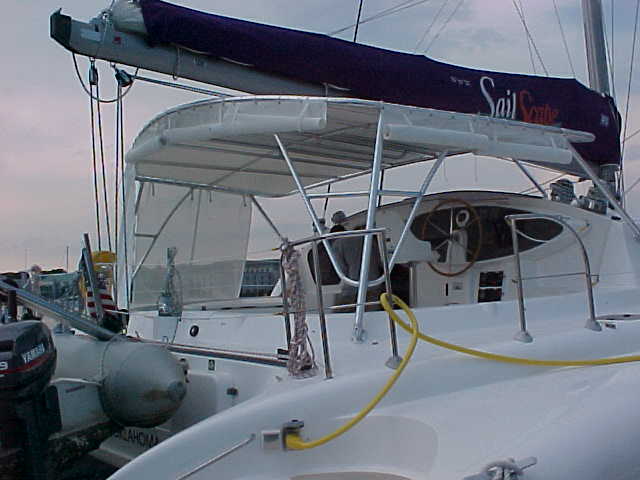
This looks like a sport fishing outfitter’s stock bimini offering. Some interference with ready cockpit access is unavoidable but the excessive bracing doesn’t help. Looks like aluminum and fabric so it would be light weight (good). Off topic but; the astronautical boat design looked better at the boat show than it does now. The visionary transom steps deliver you on to a sloping surface designed to stub your toe on the cleat before your feet slide overboard. Maybe you can buy semi-elliptical instrument displays to fit the helm console? Not really defensible design in any rational sense.
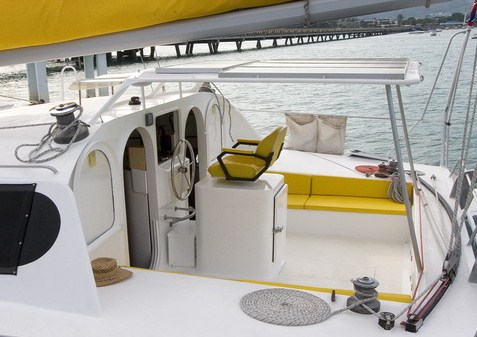
Ikea goes to sea
Yellow and white always puts me in mind of a boiled egg, which is also very neat, simple, uncluttered, lightweight, colour co-ordinated. The cockpit seats look as uncomfortable as a picnic table. But the simplicity is rather refreshing, hmm, breakfast.
